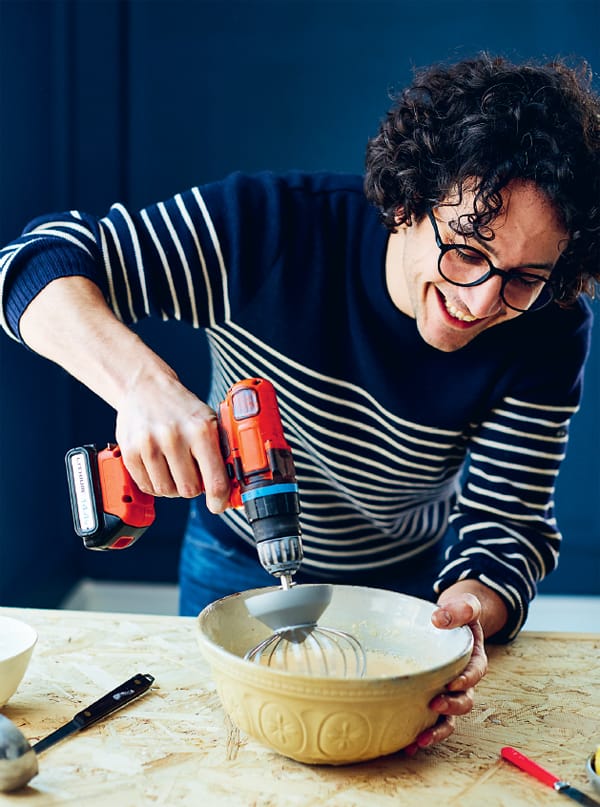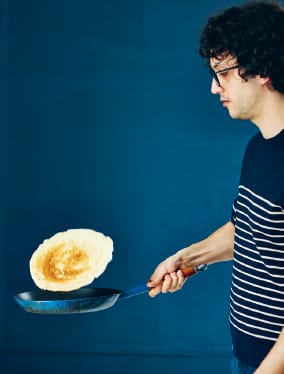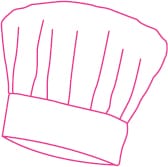
French crêpes: you can do this

Crêpes in France are much larger and thinner than those in the UK or USA but there’s no need to feel intimidated about making them. The secret is the batter, which is runnier and thinner in France, as double the quantity of milk is added. This makes the batter spread out more quickly to the edges of the pan. Feeling better now?
Makes 12–18 crêpes
about 450ml [scant 2 cups] whole milk
3 eggs
125g [1 cup] plain [all-purpose] flour
a large pinch of sugar
a pinch of salt
3 Tbsp butter
In a large bowl, whisk together 350ml [1½ cups] of the milk and the eggs. Gradually add the flour, whisking all the time, so the batter thickens slowly without any lumps forming. I find this way of making the batter efficient but terribly slow. If you have a blender or food mixer, chuck everything in it, blitz or whizz together and that’s it. The texture of the batter should be close to that of buttermilk, so if it’s too thick, add more milk, a little at a time. Finally, whisk in the sugar and salt.
Have a large (larger than your frying pan [skillet]) heatproof bowl of cold water to hand. Put your largest frying pan over a medium-high heat and add the butter. It will melt, become mousse-like and then start to ‘sing’ more and more loudly. When it begins to settle down – and particularly before it becomes too amber-coloured – take the pan off the heat and dip the base in the bowl of cold water to stop the butter cooking any more. Carefully pour this ‘noisette’ butter into the batter, stirring all the time.
Wipe out the pan with kitchen paper [paper towels] and put it back on the heat. The technique for cooking crêpes isn’t complicated but it demands a certain amount of organization. So, have the bowl of batter with a ladle in it beside the hob, the frying pan in front of you, a sheet of oiled kitchen paper within reach and finally a large plate with a lid to cover it on the other side.
Lift the pan with your right hand (I’m right-handed) and pour a ladle of batter into it. At the same time as you pour, swirl and tilt the pan in all directions. The entire base of the pan must be covered with the batter.
When the crêpe has almost finished producing steam – after about 1–2 minutes – release it from the pan with a spatula and flip it over. Continue cooking until both sides of the crêpe are evenly golden brown. Slide the crêpe out of the pan onto the plate and keep it covered while you cook the rest of the batter, rubbing the pan between each crêpe with the oiled kitchen paper.
SWEET OR SAVOURY?
In France and the UK, the tradition is to eat sweet crêpes with either butter and sugar or sugar and lemon. However, after having tasted a crêpe with ham, cheese and spring onions, you’ll realize that this convention is so last year.

Even though a crêpe with sugar and butter is still my favourite, by adding a few toppings without reheating the crêpe, you can transform this little treat into a grand dessert. It works brilliantly.
Banana, pecans and maple syrup
1 banana, 5 pecan halves, 1 Tbsp maple syrup, finely grated zest of ½ lime
Cut the banana into thin slices. Break the pecans into small pieces. Put these on a crêpe, drizzle over the maple syrup and scatter with the lime zest. The zest will counterbalance the sweetness perfectly.
Yogurt, honey and pistachios
3 Tbsp full-fat natural Greek yogurt, 1 Tbsp runny [clear] honey, 5–10 roasted and salted pistachios, chopped into small pieces
Lightly mix the yogurt, honey and half the pistachios together and spread over the crêpe. Scatter the rest of the pistachios over the filled and folded crêpe.
Red berries, almonds and cream
5–10 red berries (strawberries, raspberries, blackcurrants and/or redcurrants), 2 Tbsp double [heavy] cream, a few flaked [slivered] almonds
Roughly crush the red berries without reducing them to a pulp. Lightly fold them into the cream. Toast the flaked almonds as this will boost their flavour. Spoon onto a crêpe.
If you’ve got some basil, scatter over a few small leaves just before serving so you can play the part of the great chef.
Hazelnuts and chocolate
5–10 hazelnuts, 1 Tbsp dark [semisweet] chocolate, melted, 1 Tbsp sweetened condensed milk
Chop the hazelnuts into small pieces. Heat the chocolate in the microwave and mix with the condensed milk. Spoon onto a crêpe and scatter over the hazelnuts.
Buckwheat crêpes: you can do this, too
I said to myself that if I gave this recipe a straightforward title instead of its French name galette, you’d panic less and that would reduce the chance of you depriving yourself of a dish whose taste changed my perception of things. Whereas the taste of wheat is light, sweet and buttery, that of buckwheat is mysterious, toasty and nutty, and above all, it has a long aftertaste.
Makes about 8 crêpes
125g [1 cup] buckwheat flour
350ml [1½ cups] water (add an extra 60ml [¼ cup] if you skip the beer)
60ml [¼ cup] brown ale (if it’s alcohol-free you’ll need a little more water)
1 egg
a big pinch of salt
oil for the pan
a bit of butter
Mix all the ingredients together in a large bowl until you have a smooth, silky batter. It’s optional, but if you let the batter rest overnight in the refrigerator, its flavour will be more pronounced.
Put a large, flat-bottomed frying pan [skillet] over a high heat and let it heat up a bit. Dip a piece of kitchen paper [paper towel] in oil and rub it over the inside of the pan.
Lift up the pan with one hand and, with the other, pour in a ladleful of batter. It’s important that when the batter goes into the pan you hear a good sizzling sound. Swirl and tip the pan so the batter covers the base in a thin, even layer. To start with you’ll most likely find it difficult to produce a neat, even circular shape but in time you’ll get the hang of it.
When the crêpe colours underneath and gives off less steam, it’s time to turn it over with a spatula. Rub the cooked side with butter and cook the other side until the crêpe is done.
It’s the texture that determines the success of the finished dish. The crêpe should be brown and satin-like, dotted with hundreds of little holes, lightly crisp on the outside and melt-in-the-mouth in the middle.
SIMPLY THE BEST
My favourite crêpe is served plain with no toppings. Rien. Nada. Just the buckwheat, the Maillard reaction (the browning process), the butter and me. They are the dream team and (also the best way of determining if the crêpe is good.)
4 savoury toppings for buckwheat crêpes
There are an infinite number of toppings that you can pile onto a buckwheat crêpe. However, three are enough to produce a balanced dish: a star with a stand-out personality, a second player in a reliable supporting role, and finally a challenger to spice up the action. Take a crêpe, reheat it for 1 minute in a frying pan and top with one of the following combinations.
Scallops flambéed in whisky, with cream and leeks
2 scallops, oil for frying, a shot of whisky, 1 Tbsp double [heavy] cream, ½ small leek
Slice the scallops in half horizontally (if they are thinner they will fit more easily into the crêpe), brush lightly with oil and season well. Sear them in a frying pan [skillet] over a very high heat.
Take the pan off the heat, pour in the whisky and set alight, taking great care to avoid the flame that might shoot up! (Clue: don’t lean forward with your head over the pan to check when it is going to go out…). Add the cream and set to one side.
Slice the leek into thin rounds and fry in a little oil in a frying pan until they are nicely browned. Spoon the filling onto a warm crêpe and fold up to serve.
Sausage, potato and wholegrain mustard
1–2 potatoes, oil for frying, 1 sausage, 1 Tbsp wholegrain mustard
Cut the potatoes into thin slices, 2–3mm [ in] thick, season and toss them in a little oil. Cook in a frying pan [skillet] until they are nicely browned. Remove from the pan and keep warm while you fry the sausage.
in] thick, season and toss them in a little oil. Cook in a frying pan [skillet] until they are nicely browned. Remove from the pan and keep warm while you fry the sausage.
Add the sausage to the pan and fry until browned and cooked all the way through. Take the pan off the heat and cut the sausage into slices. Save the juices from the pan and mix them with the mustard. Spoon the filling onto a warm crêpe and fold up to serve.
Goat cheese, baby spinach and walnuts
40g [1½oz] firm goat cheese, 2 handfuls of baby spinach leaves, 5 walnut halves
This is the quickest to make. Cut the goat cheese into slices, 5mm [¼in] thick. Wash and dry the spinach leaves. Break the walnut halves into small pieces. Spoon the filling onto a warm crêpe and fold up to serve.
Aubergine, roasted tomatoes and toasted pine nuts
½ aubergine [eggplant], oil for frying, sea salt, 2–3 roasted tomatoes in a jar, 2 tsp pine nuts
Cut the aubergine into thick slices and fry over a gentle heat in a little olive oil and salt. After 20–30 minutes, they will be soft inside and caramelized on the outside.
Drain the roasted tomatoes and cut them into small pieces. Optional: you can toast the pine nuts in a dry frying pan to give them a better colour. Spoon the filling onto a warm crêpe and fold up to serve.
There are times in life to be bold, adventurous and even a little bit crazy. And then... there are times for having a hot breakfast under the duvet, eating comfort food that has nothing to prove. My go-to pancake recipe is exactly that. Something you already know you’ll love and that will make you feel good. Phew.
Makes 16–20 pancakes
250g [2 cups] plain [all-purpose] flour
2 tsp baking powder
1 tsp salt
2 Tbsp sugar
2 eggs
350ml [1½ cups] buttermilk
4 Tbsp melted, cooled butter, plus extra for greasing
Serving suggestions
maple syrup
crisp-fried bacon or fresh berries
Sift the flour, baking powder and salt into a mixing bowl and stir in the sugar.
Whisk the eggs and buttermilk together in another bowl or large jug until mixed and then very gradually whisk in the melted butter. Add to the dry ingredients, stirring lightly until everything is just combined – don’t beat vigorously until the batter is smooth, as it should be lumpy.
Heat a large, heavy-based non-stick frying pan [skillet] and grease lightly by rubbing a little melted butter [or oil] over it. Spoon 2 or 3 tablespoons of the batter into the pan for each pancake (cook 3 or 4 pancakes at a time) and cook for 2 minutes until the pancakes are golden brown underneath and bubbles appear on top. Flip the pancakes over and cook for another 2 minutes or until they are golden brown on the other side.
Remove from the pan and keep the pancakes warm in a clean tea towel while you cook the rest of the batter.
Serve warm topped with maple syrup and crisp-fried bacon or fresh berries.
TIP
Go easy with the stirring when you make the batter as it absolutely must not be over-mixed. If you beat it until it’s smooth, you’ll get the gluten in the flour working too hard and end up with tough, chewy pancakes. Yuck.
Buttermilk pancakes made with different grains
Why on earth make your pancakes just with wheat flour when there are dozens of different grains in this world? Here I’m giving you four but, remember, step out of your comfort zone and the world is your oyster!
Chickpea pancakes
Makes about 12 pancakes
Drain a 400-g [14-oz] can of chickpeas [garbanzo beans] and rinse them well. Tip the chickpeas into a blender, add 1 egg and blend a little bit. Add 115ml [½ cup] buttermilk, 1 tsp baking powder, a drizzle of oil, 1 Tbsp sugar and ½ tsp salt and blitz everything together until smooth. Using kitchen paper [paper towels], rub a frying pan [skillet] with a little oil and place it over a medium heat. Cook the pancakes in the same way as for my go-to buttermilk pancakes – they’ll just take a bit longer. Other than that, they’re perfect!
Rye pancakes
Makes about 16 pancakes
Mix together 60g [½ cup] rye flour with 60g [½ cup] plain [all-purpose] flour, 1 tsp baking powder, ½ tsp salt and 2 Tbsp sugar. Measure 350ml [1½ cups] buttermilk into a jug and whisk half into the dry ingredients. Beat 1 egg and the remaining buttermilk together and whisk into the flour mixture until just combined (lumps are fine). Grease a frying pan [skillet] with a little oil and cook the pancakes over a medium heat as before.
Polenta pancakes
Makes about 12 pancakes
Mix together 80g [2/3 cup] plain [all-purpose] flour, 50g [1/3 cup] instant polenta [yellow cornmeal], 1 Tbsp sugar, 1 tsp baking powder and ½ tsp salt. Whisk 1 egg with 150ml [2/3 cup] buttermilk and 4 Tbsp neutral flavoured oil and stir into the dry ingredients until lightly mixed. Grease a frying pan [skillet] with a little oil and cook the pancakes over a medium heat as before.
Buckwheat pancakes
Makes about 14 pancakes
Mix together 140g [1 cup] buckwheat flour, 2 Tbsp sugar, 2 tsp baking powder and ½ tsp salt. In another bowl or jug, whisk together 2 Tbsp melted butter, 300ml [1¼ cups] buttermilk and 1 egg. Add the milk mixture to the dry ingredients and stir until just combined – again, the mixture should be lumpy. Grease a frying pan [skillet] with a little oil and cook the pancakes over a medium heat as before.
How to fool everyone into thinking you’re a French chef

In this book, I’ve tried to get rid of the snobby elitism sometimes typical of French haute cuisine. Here it’s the opposite, as my aim is to make you appear to your friends like a Michelin-starred Parisian chef but at a fraction of the cost. I confess there is also the sadistic pleasure of being surprised when others don’t know the ‘really, really, common’ French term you’ve just used.
Au bain marie
[say: oh-bahn-mah-ree]
This is nothing more than a double boiler but, I agree, it does sound much posher. Here’s what you say:
‘Of course, you can’t make a sabayon (another one!) in a pan directly over the heat, it has to be cooked au bain marie. Gosh.’
Beurre maître d’hôtel
[say: buhr-meh-tru-doh-tell]
If you mash butter with crushed garlic and chopped parsley, you’ll get a beauty that will melt seductively over steak, chicken breast or even fish. The conversation goes like this:
‘Last night I made her my famous entrecote maître d’hôtel [the ‘with beurre’ is silent].’ ‘What did she say?’
‘Man, she was practically weeping with joy!’
Bisque
[say: bee-ss-kuh]
Any fish or shellfish soup can be called a bisque if it’s been thickened with a bit of butter and flour mashed together (that’s a beurre manié by the way). Probably one of the snobbiest big guns in your French arsenal.
‘In my opinion, making a soup was a mistake but I guess a bisque was too much to ask…’
Bouquet garni
[say: boo-kehgahr-nee]
Using thin string, tie together several sprigs of parsley and thyme, a celery stalk and a bay leaf. This aromatic bundle is used like a teabag to flavour soups, stocks and sauces. As in:
‘When he/she slowly wrapped his/her arms around me, I felt like a bouquet garni.’
Consommé
[say: konh-soa-meh]
This is just a clear broth or stock but I reckon it sounds posh, even to me. I love it and I can’t wait to slip it into the conversation when I next see my friends at a party – haha.
Jus
[say: jüüh]
I can honestly say I’d use this one to show off as well. A jus is a stock or sauce that has been well reduced so it’s packed with bold flavours.
‘Yes, the food was great but, for God’s sake, he needs to put a little more love into his jus!!!’
And – just so you know – it can also mean coffee.